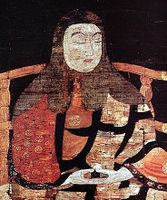Saichō
Jump to navigation
Jump to search
| English Phonetics | Saichō |
|---|---|
| Japanese Script | 最澄 |
Alternate names
- Dengyō Daishi
Dates
| Birth: | 767 |
|---|---|
| Death: | 822 |
| Place of birth: | Ōmi province, east of Hieizan |
Tibetan calendar dates
About
- Religious Affiliation
- Tendai
Other Biographical info:
Links
- Wiki Pages
Buddha Nature Project
- Person description or short bio
- In Japanese, “Most Pure”; the monk traditionally recognized as the founder of the Tendaishū in Japan; also known as Dengyō Daishi (Great Master Transmission of the Teachings). Although the exact dates and place of Saichō’s birth remain a matter of debate, he is said to have been born to an immigrant Chinese family in Ōmi province east of Hieizan in 767. At age eleven, Saichō entered the local Kokubunji and studied under the monk Gyōhyō (722-797), a disciple of the émigré Chinese monk Daoxuan (702—766). In 785, Saichō received the full monastic precepts at the monastery of Tōdaiji in Nara, after which he began a solitary retreat in a hermitage on Mt. Hiei. In 788, he built a permanent temple on the summit of Mt. Hiei. After Emperor Kanmu (r. 781-806) moved the capital to Kyōto in 794, the political significance of the Mt. Hiei community and thus Saichō seem to have attracted the attention of the emperor. In 797, Saichō was appointed a court priest (naigubu), and in 802 he was invited to the monastery of Takaosanji to participate in a lecture retreat, where he discussed the writings of the eminent Chinese monk Tiantai Zhiyi on the Saddharmapuṇḍarīkasūtra. Saichō and his disciple Gishin received permission to travel to China in order to acquire Tiantai texts. In 804, they went to the monastery of Guoqingsi on Mt. Tiantai and studied under Daosui (d.u.) and Xingman (d.u.), disciples of the eminent Chinese Tiantai monk Jingqi Zhanran. Later, they are also known to have received bodhisattva precepts (bosatsukai) from Daosui at Longxingsi. He is also said to have received tantric initiation into the kongōkai and taizōkai (ryōbu) maṇḍalas from Shunxiao (d.u.). After nine and a half months in China, Saichō returned to Japan the next year with numerous texts, which he catalogued in his Esshūroku. Emperor Kanmu, who had been ill, asked Saichō to perform the esoteric rituals that he had brought back from China as a therapeutic measure. Saichō received permission to establish the Tendai sect and successfully petitioned for two Tendai monks to be ordained each year, one for doctrinal study and one to perform esoteric rituals. After the death of Kanmu in 806, little is known of Saichō’s activities. In 810, he delivered a series of lectures at Mt. Hiei on the Saddharmapuṇḍarīkasūtra, the Suvarṇaprabhāsottamasūtra, and the Renwang jing ("Scripture for Humane Kings"). In 812, Saichō also constructed a meditation hall known as the Hokkezanmaidō. Later, Saichō is also said to have received kongōkai initiation from Kūkai at the latter’s temple Takaosanji, but their relations soured after a close disciple of Saichō’s left Saichō for Kūkai. Their already tenuous relationship was sundered completely when Saichō requested a tantric initiation from Kūkai, who replied that Saichō would need to study for three years with Kūkai first. Saichō then engaged the eminent Hossōshū (Faxlang zong) monk Tokuitsu (d.u.) in a prolonged debate concerning the buddha-nature and Tendai doctrines, such as original enlightenment. In response to Tokuitsu’s treatises Busshōshō and Chūhengikyō, Saichō composed his Shōgonjikkyō, Hokke kowaku, and Shugo kokkaishō. Also at this time, Saichō began a prolonged campaign to have an independent Mahāyāna ordination platform established at Mt. Hiei. He argued that the bodhisattva precepts as set forth in the Fanwang jing, traditionally seen as complementary to monastic ordination, should instead replace them. He argued that the Japanese were spiritually mature and therefore could dispense entirely with the hīnayāna monastic precepts and only take the Mahāyāna bodhisattva precepts. His petitions were repeatedly denied, but permission to establish the Mahāyāna ordination platform at Mt. Hiei was granted a week after his death. Before his death Saichō also composed the Hokke shūku and appointed Gishin as his successor. (Source: "Saichō." In The Princeton Dictionary of Buddhism, 737. Princeton University Press, 2014.)
Expand to see this person's philosophical positions on Buddha-nature.
| Is Buddha-nature considered definitive or provisional? | |
|---|---|
| Position: | |
| Notes: | |
| All beings have Buddha-nature | |
| Position: | |
| If "Qualified", explain: | |
| Notes: | |
| Which Wheel Turning | |
| Position: | |
| Notes: | |
| Yogācāra vs Madhyamaka | |
| Position: | |
| Notes: | |
| Zhentong vs Rangtong | |
| Position: | |
| Notes: | |
| Promotes how many vehicles? | |
| Position: | |
| Notes: | |
| Analytic vs Meditative Tradition | |
| Position: | |
| Notes: | |
| What is Buddha-nature? | |
| Position: | |
| Notes: | |
| Svātantrika (རང་རྒྱུད་) vs Prāsaṅgika (ཐལ་འགྱུར་པ་) | |
| Position: | |
| Notes: | |
| Causal nature of the vajrapāda | |
| Position: | |
